- Know about 12 unusual temples of India
for e.g. Yoginis are worshipped, rats too, affidavits offered to Deity and visa
giving Balaji temple.
Every Hindu temple is a home of its
deities, where they live just like we live in our homes, following a set
routine through the day and celebrating special occasions around the year.
Temples themselves are a form of Deity, designed to make us feel their presence
at both the gross and subtle levels.
Historically, as a public place
that belongs to everyone, they have been the nerve system that keeps society
together. These sacred chambers and their ecosystems have evolved along with
human civilization. The variety and diversity of temple structure, a science
and an art in itself, marries aesthetics and storytelling with brilliant
architecture and engineering. The essence of the temple is the relationship
between its enshrined Deity and the devotees who take care of that Being,
worship and share their everyday joys and sorrows with the Deity. It is here
that the most intimate communion occurs between Deity and devotees.
We find magnificent stone temples
in the southern parts of India and glimpse them in the ruins of North India,
but it is easy to miss the unusual, simple temples scattered all around the
land of Bharat. Each of those sites has a unique story, showing how temple
traditions can arise from specific circumstances and situations. They also tell
us about the immense faith Hindus have in their Deities, to approach them like
a child reaching out to parents or friends, sharing their love, needs and
best-kept secrets.
Come with me for a journey to some
of India’s unique and unusual temples. Some may surprise you and expand your
concept of what a temple can be.
This article
was first published in Hinduism Today.
Karnataka
1. On the riverbed
of Shalmala
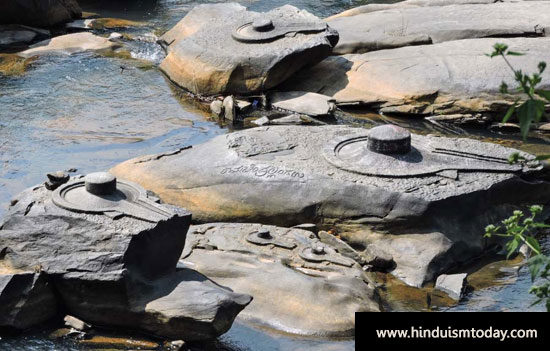 Sivalinga carved into the river Shalmala receive abhishekham as the water flows.
Sivalinga carved into the river Shalmala receive abhishekham as the water flows.
In the village of Sonda, about 10.5
miles from the town of Sirsi in the South Indian state of Karnataka, the
Shalmala river flows quietly through lush green forests. Approaching the river,
you see carved granite stones all around, but nothing prepares you for what you
see at the river when the water levels are low. All over the riverbed are
boulders finely carved with Sivalingas and Nandi bulls, the vahana of Siva, as
well as some Nagas, or serpent sculptures. Some larger boulders have been
creatively chiselled to look like a big bull. Some of the carvings are
unfinished. Sometimes the Sivalinga is done but the Nandi has just been marked
on the stone; in some cases the Linga is half finished.
Looking at the base of the boulders,
you realize they are a part of the riverbed, therefore must have been
carved in situ. As the stones stay submerged in the river
for the better part of the year, the carving must have been performed in the
dry summer months when they became accessible. Imagine sculptors sitting in the
middle of the river with their hammers and chisels to carve out Siva and His
vahana.
Legend goes that the King of Sonda,
Swadi Akasappa Nayaka, was childless. Advised to create 1,008 Sivalingas to acquire
offspring, he had every stone available to him carved into a Sivalinga. He was
indeed blessed with children, so these can be seen as a mark of wish
fulfilment. This riverbed has a sibling in Cambodia, where thousands of Lingas are carved on the
bed of Siem Reap River. Traditions have mysterious ways of traveling great
distances.
Hyderabad
2. Visa-Giving
Chilkur Balaji
On the outskirts of Hyderabad is a small
temple with blue walls and colorful gopurams. The shops outside give you a
punch card and a pen along with the flowers and other offerings for the temple.
This is puzzling unless you know the tradition here. Inside the grounds you see
everyone carrying the card and pen as they do parikrama, or
circumambulations, around the tiny temple. The card has 108 numbered boxes, to
count the optimum number of parikramas. On completing each round, you bow
before the Deity and punch the card, then start the next circle.
This is how devotees thank the Deity,
Chilkur Balaji, for obtaining a visa—to travel to their dream destination for
education, work or leisure. It seems that in the 1980s, people wanting to go
abroad, mostly for study, prayed here for quick visas, and their wishes were
granted. The trend caught on, and the temple came to be known as the Visa Temple.
Fittingly, chilkur means small, and the
temple is dedicated to Balaji. History tells how a devotee, unable to make his
annual visit to the grand Tirupati Balaji Temple due to ill health, discovered
a murti of Balaji here. Balaji had appeared to him in a vision to fulfill his
wish, and the temple was constructed to mark the appearance. Over time, the
practice developed to make eleven rounds of the temple while making a wish.
When your wish comes true, you come back and do 108 parikramas. So, those who are
circumambulating with punch card in hand are actually thanking the Deity for a
wish fulfilled.
Unusually, this temple has no hundi
(donation box). It does not accept donations. One is also advised not to close
their eyes while praying, but talk to Balaji eye to eye. Possibly because wish
fulfilment is the focus of this temple, a priest told me this is a temple of
the young, where children bring their parents rather than the other way round.
Kumaon–Uttarakhand
3. Nyata Devata – God of Justice
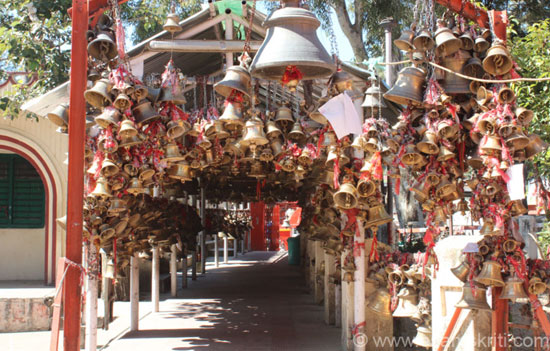 Bells throng gateway to temple.
Bells throng gateway to temple.
In the Kumaon hills of Uttarakhand,
surrounded by tall deodar trees, is the temple of Golu Devta, the presiding
Deity of this region. Entering the temple, you are surrounded by thousands of
brass bells. Small, big, huge and giant brass bells hang everywhere, most of
them tied with a red cloth called chunri.
Hanging from the walls of the corridor
around the sanctum are piles of judicial stamp papers and handwritten letters.
The Deity here is Nyay Devta, the God
of Justice. When legal battles are not solved in court and people do not get
justice in the world of humans, they put their petitions before Golu Devta to
sort out disputes and disagreements. Petitioners firmly believe He will deliver
justice to them in His own way.
Reading a few of these letters, you
understand the devotees’ deep connection with the God. For example, a person
with a terminally ill family member writes that the doctors have tried their
best, but doctors are only human after all, requesting divine intervention from
Golu Devta. Students share their dreams with him, seek help in clearing
competitive exams, and request guidance in staying on the right path throughout
their lives.
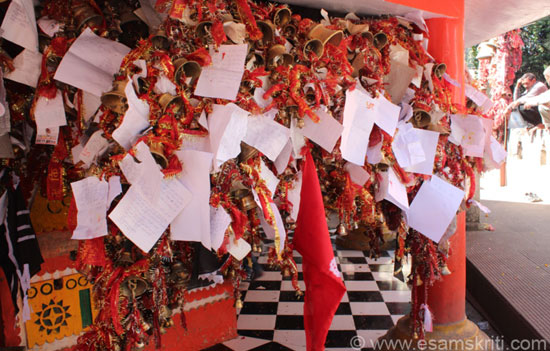 Hand-written letters/affidavits addressed to Golu Devta.
Hand-written letters/affidavits addressed to Golu Devta.
Golu Devta is considered as an incarnation
of Gaur Bhairav (Siva), and is worshiped all over the region. Legends connect
Him to the two primary dynasties that ruled this region—Chand and Katyuri. It
is said that when he was born, his stepmothers replaced him with a stone in the
palace and left him near the river, where he was saved and raised by a
fisherman.
As a child, he took a wooden horse to the
lake, where his stepmothers were bathing, and asked it to drink water. When his
stepmothers laughed, he told them that if a woman can give birth to a stone,
why can’t a wooden horse drink water? His father heard of this, understood what
had happened and made him the king. He was well known for his delivery of
justice during his rule and continues to be approached for that purpose. The
wooden horse became his vahana or vehicle; in the temple, he can be seen riding
a white wooden horse.
As for the bells, devotees tie one when
their wishes are fulfilled: all those bells represent wishes that have been
fulfilled.
Varanasi
4. World of Miniature Shivalingas
Kashi, or varanasi, is
the spiritual epicenter of India, some say of the world. It is the city of
Siva; where one can find a Sivalinga or a small Siva temple in nearly every
nook and corner. Hindus nearing death come to Kashi to look at death
face-to-face at Manikarnika Ghat and Harishchandra Ghat.
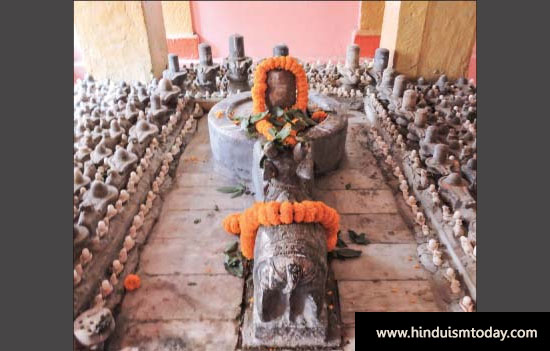 One of the many rooms of the Jangamwadi Math filled with a thousand and eight Sivalingas.
One of the many rooms of the Jangamwadi Math filled with a thousand and eight Sivalingas.
In the ancient Jangamwadi Math, located
not far from the famous Dashashwamedha Ghat, one finds a million miniature
Sivalingas. This math belongs to the Vira
Shaiva or Lingayat community that primarily hails from the states of
Karnataka and Maharashtra, as evidenced by the sign boards in Kannada and
Marathi here. This sect believes in and worships Sivalinga and nothing else.
Their journey with that aniconic mark of God starts even before birth, when a
small Sivalinga is tied around the belly of the expectant mother to protect the
infant. Soon after birth, the same Sivalinga is placed on a string around the
baby’s neck.
Jangamwadi Math has rooms full of
miniature Sivalingas neatly arranged in rows, usually surrounding a larger
Sivalinga. Thousands surround the Sivalinga inside the main temple. These are
offered by the devotees during the auspicious month of Shravana, which falls
during the monsoon months and is well known across India for worship of Siva.
Devotees offer Sivalingas for departed loved ones, especially those who died an
unnatural death, and as part of the usual rites for departed ancestors.
Wherever you stand in the Math, you see so many Sivalingas that you are struck
by the presence of Siva around you. No one tries to precisely quantify the number
of Sivalingas here, they are so numerous and many more keep coming in.
Chattisgarh
5. Rudra Siva of
Tala
The 7th- and 8th-century ruins of Tala are situated at the
confluence of the Shivnath and Maniari rivers in Chhattisgarh’s Bilaspur
District in in central eastern India.
The place is widely known for the Devrani Jethani temple,
which looks beautiful even in its utterly decimated condition. A 20th-century
excavation here revealed a stunning piece of sculpture—a two-meter-tall murti
in red sandstone of a Deity in the standing posture. Uniquely, the various body
parts are carved using all possible animals and serpents. This is an excellent
example of composite art, where a larger image is created using the smaller
complete images of related or unrelated objects. The headgear is a coil of snakes,
the nose a combination of chameleon and scorpion, the ears as peacocks,
eyebrows as frogs, shoulders as crocodiles, fingers like five-fanged snakes,
breasts as humans, belly as pot, lions on knees, and many more beings in finer
details.
Serpents dominate the sculpture from top
to bottom. There are also many signs of the zodiac. Unfortunately, some parts
of the murti have broken, and we may have lost some crucial details. It is
locally called Rudra Siva, and may
represent the Pashupatinath form of Siva where He is seen as the protector of pashus, (“animals” or
“beings”).
Rudra Siva, the signature sculpture of the
state of Chhattisgarh, has been replicated in museums elsewhere. Yet, no other
known sculpture is similar to this one. This uniqueness may be rooted in the
place it was found. Currently it is kept locked at the site, though you can see
it from outside. We do not know what the sculptor was trying to convey, nor the
intention of the patron who commissioned this unusual sculpture.
Odisha
6. Chausath Yogini
Temple
Other
unique sculptures are found in the Yogini temples, most of which are lost to
us. Thankfully a few survive in central and eastern India. Close to the east
coast, near the city of Bhubaneswar in Odisha, is Hirapur, a small village
named after a queen. This is home to one of the smaller but relatively
better-preserved Chausath Yogini temples, dating back to the 9th century
ce. Chausath in Sanskrit and Hindi means sixty-four. These temples
are dedicated to the groups of 64 Yoginis who serve Siva and Shakti. They are
in fact the manifestations of Shakti Herself.
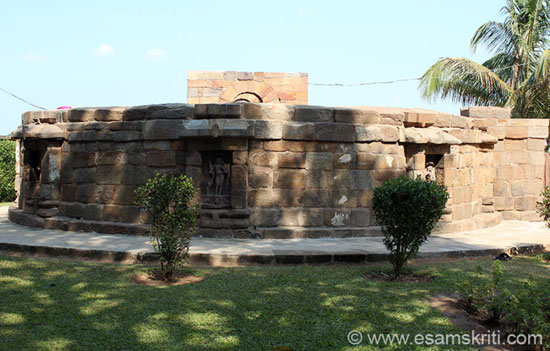 Temple, round in shape. This is one of
many temples built in reference to the 64 Yoginis, believed to be a
manifestation of Shakti Herself.
Temple, round in shape. This is one of
many temples built in reference to the 64 Yoginis, believed to be a
manifestation of Shakti Herself.
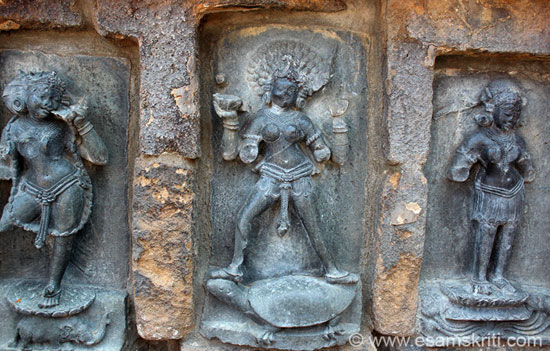 E.gs of Yoginis. Left to right is Narmada, Yamuna, Shanti/Laxmi.
E.gs of Yoginis. Left to right is Narmada, Yamuna, Shanti/Laxmi.
Most classical temples are rectangular in
shape, with a tall shikhara, or superstructure, over the garbhagriha, the
sanctum sanctorum.
In contrast, Chausath Yogini temples have
no roof; they are open to the sky, freely interacting with the elements. They
are circular in shape, with a small entrance. Seen from above, they resemble
the yoni, female genitals, a symbol of fertility and creation. They also
resemble a wheel, called yogini chakra. In the center is the place for a
Sivalinga, which is surrounded by the murtis of Yoginis carved on the inner
circular wall of the temple. Each Yogini is identifiable through the ayudhas,
or icons, in her hands, or the vahanas or vehicles She rides or stands on. The
moods of the Yoginis vary from benevolent to fierce.
No two Yogini temples have the same set of
Yoginis on their walls. At Hirapur, for example, one sees the rare murti of
Vinayaki, the Shakti of Vinayaka or Ganesha. The chief Yogini in Chausath,
located opposite the entrance, is Mahamaya, who stands upon a human head. Well
adorned with garments and flowers, She is worshiped regularly. Other Yoginis,
too, are offered flowers. In the middle is a platform with Bhairava murtis.
Chandi Path, the most popular yagna for Shakti worship, is performed here
during Navaratri. On the outer periphery of the circular temple are nine larger
murtis of Goddess Durga. In the middle of Mahamaya Pushkarni tank, close by, is
a small square temple, as is typical of village tanks in Odisha.
New Delhi, India’s capital, was once called Yoginipura, the city of Yoginis. Only one Yogini temple there has
survived the ravages of invasions and time-the Yogmaya temple near the famous Qutub Minar, which was built after
destroying 27 Hindu and Jain temples, many of which may have been Yogini
temples. The parliament building in Delhi was built in a circular design
resembling the Chausath Yogini temples.
Goa
7. Becoming Krishna
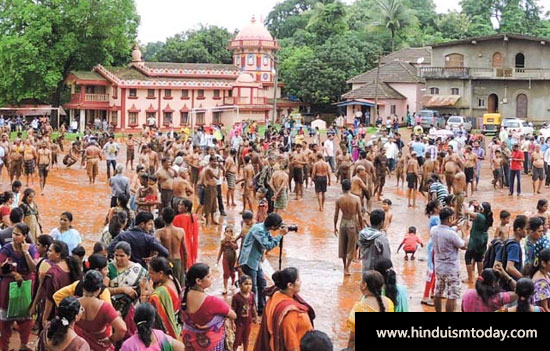 Mud Festival at the Devaki Krishna Temple in Goa.
Mud Festival at the Devaki Krishna Temple in Goa.
The
village of marcel, in goa, is home to the Devaki Krishna temple. Immediately
after Devaki gave birth to Krishna in jail in Mathura, He was taken across the
river Yamuna to Gokul village, where He grew up with Yashoda, His foster
mother. Devaki and Krishna never met during His childhood. It is said that when
Devaki finally saw grown-up Krishna, she yearned to hold Him in her arms as an
infant—and Krishna took the form of an infant to fulfill His mother’s desire.
The temple celebrates that moment; its main murti has Devaki holding baby
Krishna. This is the only temple dedicated to the mother-son duo.
This
temple is also known for its unique mud festival, held in July during the peak
monsoon season, when the ground is sloshy with mud. Males in the village, from
toddlers to seniors, gather in front of the temple. The owner of a local
grocery store applies coconut oil to their bodies, with elders putting cotton
in their ears to denote all who have been oiled. Then all chant “Jai Vitthal,
Hari Vitthal” and enter the temple. They take a bit of oil from the temple’s
big oil tub, dab it on their bodies, and return outside to play games in the
mud—blind man’s game, tug of war, kabaddi and many more, concluding it all with
a war of words.
These
are believed to be the same games that Krishna played in his youth, which they
are re-enacting for the pleasure of Devaki, the Deity of this temple, who
missed this during her son’s childhood.
Meanwhile,
the village families are distributing sweets to everyone present. In the final
act, Dahi Handi, men form a pyramid to reach a pot of curd hung high on the
tree. The pot is broken and the curd falls on everyone in the pyramid. They
then go to the local washermen’s quarters to clean bathe. This is one of the
most fun festivals you can witness. Some see it as an annual earthing
exercise.
Kerala
8. Calming your Nerves
In
the Chottanikara Temple in the city of Kochi in Kerala, Devi—as She who
enlightens—lives in her Trigunatamak form, which embodies all the three
qualities (sattva, rajas and tamas) in the one murti. There is a
fascinating story about how Adi Shankaracharya brought her to this area, his
land of birth; but the uniqueness of this temple is its ability to cure mental
disorders.
One level below the main temple here,
connected by a wide staircase surrounded by a temple tank, is the Kizhukkavu
Temple, where pujas are performed here for the mentally disturbed. The Guruthi
Puja, performed on Friday evenings, is considered particularly beneficial for
mental issues, but to get completely cured, the prescribed worship is for 41
days. People who have been cured return and conclude the process by putting a
nail into a tree at the temple with a hammer they bring with them. Many nails
adorn the thick tree trunks here.
Dozens of small wooden cradles hang from
the same trees, tied by those who hope the Goddess will bestow them with
children so that their homes, too, will have cradles.
A unique way to worship here is the
bursting of firecrackers. There is a counter where you can buy a ticket, and an
official there will burst the crackers on your behalf. These sound almost like
gunshots. Incidentally, gun salutes to the Goddess are given at many Goddess
temples in India.
Himachal Pradesh
9. Mummy in
Meditation
Unlike Egypt, India is not known for its mummies. However,
some saints and lamas have entered samadhi while meditating and turned
themselves into mummies.
One such can be seen in the small Himalayan village of Giu,
in the Spiti valley of Himachal Pradesh, where the mummy of a Buddhist lama was
discovered some years ago when a road was being repaired. Locals believe he was
Sangha Tenzin, a monk of the Gelugpa order of Buddhism. He is sitting in a
meditation, one hand in dhyana mudra with tips of forefinger and thumb
touching. His nails and hair are said to still be growing, and his teeth are
intact.
Radiocarbon dating tells us the mummy is
roughly 550 years old, and the lama was in his early 40s when he died. No trace
of any chemical has been found on his body. Some believe this monk knew a
technique of natural self-mummification by gradually giving up food while
entering a deep meditative state. Others propose he was buried under an
avalanche while meditating in this cold desert region amidst naked snow-clad
mountains.
Though Giu can only be reached by a detour
from any other route, the lama is starting to turn this remote Himalayan
village into a tourist destination. A temple has been built around the mummy,
which is wrapped in the yellow monastic robes and protected within a glass
enclosure. It is surrounded by coins, currency and other items of worship
offered by visitors.
Rajasthan
10. Where Rats
rule, Bikaner
The famous Karni Mata Temple, popularly
known as the Rat Temple, is located in Deshnoke village, close to Bikaner in
Rajasthan.
The premises swarm with thousands of rats,
lovingly called Kaabas and treated as
the progeny of the presiding Deity Karni Mata, who lived some 600 years ago.
She is the kuladevi (family
protectress) of the Charan community here and of the royal family of Bikaner.
Over time she came to be revered as a Goddess, and the rats here as her
children. Her temple is modest, with a small murti of her that has been covered
with silver. Nearby her life, documented in a fort-like museum, honoring her as
an illustrious ancestor who and saved the community through miraculous deeds.
Karni Mata is also considered a form of
Hinglaj Mata, whose hill shrine is now part of Pakistan.
Most of the rats here are brown. The few
white ones are considered extremely auspicious, so people visiting the temple
look around for them. Seeing a white rat is believed to bring loads of good
luck.
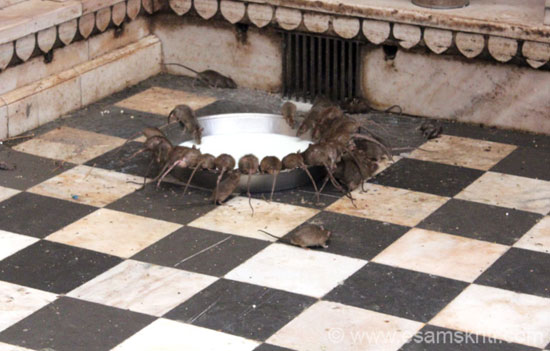 Rats feast on milk. Karni Mata Mandir.
Rats feast on milk. Karni Mata Mandir.
Here rats get priority over everyone else. The temple is their home, and you are just a visitor. Everywhere are pots of milk and piles of yellow bundi laddus, which the rats feast in great numbers. The marble façade of the temple is carved with rows of rats, each holding a laddu in its hands. Visitors must enter the temple barefoot, not even wearing socks. They cannot step over a rat or hurt one in any way. If by mistake you hurt one, you have to offer one made in silver at the temple. This unique temple reminds us to peacefully coexist with all kinds of living beings, as we are all the children of the same mother nature. It is believed that the total number of people in the Charan community and rats remains constant.
Sikkim
11. Baba Mandir of Nathula La
In
the high Himalayan mountains of Sikkim, near Nathula Pass, is the scenic Tsomgo
Lake, 38.5 miles from Gangtok. At an elevation of over 12,000 feet, this
tourist attraction stays frozen most of the year. This is a border area between
India and China and has often seen military action. Near the lake is the Baba
Mandir, a unique temple dedicated to Sepoy Harbhajan Singh from Punjab, soldier
who served in the Indian Army in the 1960s.
While
leading a mission here, he fell into an icy cold river and died. His body was
lost for days, until he appeared in the dreams of his comrades and directed
them to his corpse. His bunker was converted into a memorial temple. There a
photograph of him in full military uniform is enshrined, and an empty chair is
kept for him at meetings. It is believed he continues to perform his duty at
the border by keeping guard at night and warning Indian sentries through
dreams. People bring back bottles of water from here as his blessing. This is a
legend we have seen taking birth in our own generation.
Varanasi
12. Ode to Bharat Mata
This
essay cannot be complete without mention of Bharat Mata temples, which can be
seen at Varanasi, Haridwar, Ujjain and few other places. In Sanatana Dharma,
the Earth has always been treated as mother. Motherland refers to the land we
took birth in and belong to. Bharat Mata is a Deity
that came into manifestation during the Indian Independence movement.
The
first painting of Bharat Mata was created in 1905 by Rabanindranath Tagore,
nephew of Rabindranath Tagore. She is depicted wearing a saffron sari and, like
most Goddesses, having four arms. The two upper hands hold the scriptures and a
piece of white cloth; the lower hands hold a sheaf of paddy and an akshamala
(string of prayer beads). Thus, She holds the essentials of human life, Shiksha-Diksha-Anna-Vastra: education,
initiation, food and clothing. The original painting can now be seen at
Victoria Memorial Hall Museum in Kolkata.
Within
a couple of decades, a temple to Bharat Mata was built in Varanasi by Babu Siva
Prasad Gupta, enshrining a to-scale 3D topographic map of India. Carved in
marble from Makrana in Rajasthan, the map depicts, water bodies, oceans,
islands, plateaus, plains and over 450 mountain peaks. Poet Maithili Sharan
Gupta wrote an ode to this temple, and Mahatma Gandhi inaugurated it in
1936.
Conclusion
Studying
and visiting these unique temples give us a glimpse of how their legends were
formed, slowly took the shape of beliefs and finally became tradition. We also
learn of the devotees’ faith in these temples, which is strengthened every time
their wishes manifest, as evidenced in the rituals associated with thanking the
Deity.
Formal
temple architecture is a well-established art and science, but there are many
temples that take a detour and carve their own niche. Some variations, like
Golu Devta and Karni Mata, are limited to a small region, while others can be
found across the country. Some deliver justice, others relieve pain, and some
simply leave you wondering about their story. Some celebrate the land, while
others celebrate its brave men and women. Anyone who nurtures or enlightens can
be a Deity for us—be it the land, facets of nature, living beings or unseen
elementals with whom we coexist.
Author Anuradha Goyal is a respected and well known travel blogger, speaker, columnist and author. Her travel blog Her personal site
This article was first published in Hinduism Today
and Here eSamskriti has obtained permission from Hinduism Today to share. Some pictures are watermarked HinduismToday and others www.esamskriti.com. Copyright lies with them.
Also see
albums
1. Karni
Mata Mandir, Bikaner
2. Chausath
Yogini Temple, Odisha
3. Chausath
Yogini Mandir, Jabalpur
4. Chausath
Yogini Mandir, Morena
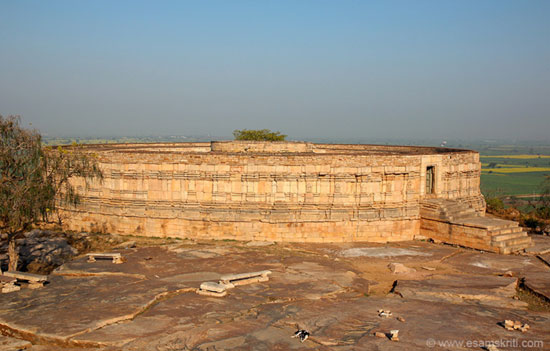 Chausath Yogini Mandir, Morena, M.P. is round like other Yogini temples.
Chausath Yogini Mandir, Morena, M.P. is round like other Yogini temples.